|
After Denmark was occupied by the Germans on April 9, 1940, numerous Danish ships still sailed
at sea who could return to their ports. Many of these ships sought salvation, among others,
in British ports. A large part of the crews decided to join the
Allied army. Between 1940 and 1945 there were around 6000 Danish sailors in Allied service (of this
around a 1000 would perish in battle).

The monument for the Danish sailors who were active during D-Day
During Operation 'Overlord' more than thirty Danish ships were present in the
fleet which were active on 6 June 1944. Twentyfour of those sailed under the Danneborg (Danish flag). More than 800
Danish seamen were involved in the landings in Normandy. To commemorate this fact a large monument has been erected on the D 913,
towards the Utah Beach Museum.
6 JUNI 1944, 06.30 UUR OBJECT: UTAH BEACH Just before you reach the museum on ´Exit 2´, there is a left-hand lane towards La Madelèine, where it is possible to visit a small chapel. This was ones the place where one of the first services after the landingswas held by the Americans. After this visit head for the area with the museum on Utah Beach.

The chapel of La Madelèine, Then and Now

THE UTAH BEACH MUSEUM: The museum is built around a former German bunker. Because of a recent update and the building ofa new wing, which houses a B-26 Marauder bomber, it's well worth the visit. In the same hall where the bomber is placed, a smaller hall is to be found where room is for temporary exhibitions. Inside can also be found the LCVP and LVT landingcraft that were once exposed to the weather for many years. Both craft are restored to their former glory.  The Utah Beach Museum (in 2011 a new wing was completed) The Utah Beach Museum (in 2011 a new wing was completed) At the entrance to the beach stands a marker '00' (an identical one stands, with its 'zero' number, near the town hall in Ste-Mère-Église). Here starts the 4th Division Liberty Highway. It runs all the way through France into Belgium and Holland. The restaurant across the road is built around a bunker as well. This one is completely restored and open for visitors (watch your head!).

The
restaurant across Utah Beach Museum, Then and
Now

In the early hours of June 6th, 1944, Leutnant Arthur Jahnke
sent a German patrol out to find out what all the those planes
in the sky were doing. An half an hour later the patrol
returned and brought to the surprise of Jahnke 17 American
prisoners with them! The Germans tried to interrogate the
prisoners but the American paratroopers said nothing, and
there was no time for further interrogation because the
shelling started from the navy ships that lay in the waters of
Utah Beach. The bombardment destroyed the 50mm, 75mm and 88mm
guns around the fortifications. German troops that were not
killed or wounded were wandering around dazed and confused.

On September 27,
2008, a new monument was unveiled at Utah Beach,
to remember the gallant American Navy
Under the command of General Roosevelt the 4th Division
stormed Utah Beach. Because of a small mistake and the tidal current,
they landed a couple of kilometers more to the south. This was
a fortunate 'mistake' because the defense was at this place
very weak. Jahnke and his troops were quickly overrun and
taken prisoner. At the end of the day there were already
23.000 man on the beaches and 1700 vehicles debarked.
TAKE THE COASTAL ROAD TO THE NORTH:
The next exit through the dunes from the beach is known as
'EXIT 3'. Around 07.30 hours a part of 502nd PIR (Parachute
Infantry Regiment), 101st Airborne Division, under command of
the 3rd Battalion lay in ambush at this point.
 One of three
H655 bunkers just beyond Exit-3
One of three
H655 bunkers just beyond Exit-3
At 09.30 hours
a large group of Germans appeared who were retreating from
the fighting on the beach. In the fight at this exit 75
Germans lost their lives. Utah Beach was also the sector where
General Patton's 3rd Army landed. The dunes here are scattered
with bunkers and blockhauses. In the fields behind the dunes
still some holes can be found of the aerial bombardment.
 Near the
Leclerc Monument a Sherman tank can be found
Near the
Leclerc Monument a Sherman tank can be found
A kilometer to the west stands the Leclerc Monument with three vehicles,
one a Sherman tank. Untill 2007 there were also rusting away an M8 and an
M3 Half-track. They brought to a restoration facility, and after some time they
were returnd. The vehicles are far from complete, the M8 is okay, but the Half-track is
an empty hull without it's fenders.
 At the front the Half-track,
with behind it the M8 Greyhound
At the front the Half-track,
with behind it the M8 Greyhound Behind the monument for
Leclerc and his Free French, 50 meters to the North, Wn 10 can be found.
This is also worth a visit with it's heavy casemates (R612 for 75mm guns or 10,5cm K331(f))
and other bunkers. The beach is a fantastic place for a nice walk. At low
tide pieces of a Rhino landing barge are still visible in the sand. Also
at low tide, a 500 meters out of the coast, remnants of the Goosberry can
be observed sticking out of the sea. A mere 250 meters south St 9 can be
found also with two R677 casemates, but this time for 88mm guns.

CONTINUE TO THE NORTH ON THE COASTAL
ROAD: Batterie de Crisbecq
Follow the signes; 'Batterie de Crisbecq'. Head inland on
the D 69. Here are some enormous bunkers for heavy artillery.

The directionfinder of the Batterie de Crisbecq
In July 1941, construction of the battery began with the addition of six open emplacements for 15.5 cm guns.
The guns were captured French 155mm GPF (Grande Portee Filloux), with the German designation 15,5cm K418 (f)
The construction would consist of three phases, first the open emplagements, then from November 1942 to July 1943 the
construction of three R 134 ammunition bunkers, five crew bunkers and two fire routing bunkers. Finally, from January 1944
until June of that year four large R 683 casemates would be built with 21cm Skoda K39/41 guns
(of which two were ready and a third was under construction on 6 June 1944).
Also a casemate M 272 would be built for a 15cm gun (not constructed).
 A casemat Type H 683 at Crisbecq, Then and Now
A casemat Type H 683 at Crisbecq, Then and Now

In the early morning of the 11th of June, the battery was virtually out of action, no more ammunition and bandages was left.
The defense managed to hold until the end of the day, but shortly after midnight Ohmsen left the complex with 78 men.
There were 21 wounded left in the battery, plus 126 American prisoners. The next morning, the 2nd Battalion,
39th Infantry Regiment of 90th Division entered the complex and found it abandoned. It may be a small miracle
that the battery hold out for so long. Battery Azeville was taken on 9 June during the day.
American engineers placed huge quantities of explosives in the No.1
casemate and and detonated it. The 40-ton gun was blown out of the casemate.
The walls arched and the ceiling collapsed.
On 21 August 1944 there was a huge explosion in No.2 casemate. All ammunition of the complex
was stored in this casemate. The entire rear side collapsed and the ceiling came down.
A large number of Americans around this casemate were killed and many were injured. Probably because of
carelessly, the case has exploded.
Batterie d'Azeville
After the visit of Crisbecq head inland and go to 'Batterie
d'Azeville. This complex is well worth the visit. The battery has four casemates;
two H671 and two H650 (the last one has an extra concrete protection on top for a 37mm anti-aircraft
cannon). During the night of June 5 and 6, 1944 there was some heavy fighting between paratroopers and
the defense of the complex. In the morning the heavy guns of the battery were pointed towards Utah Beach.

During the night of June 8 and 9, the most north H650 casemate, was hit twice by 35,6cm
shells from the battleship USS Nevada. One hit the outside structure on the left side,
but the other went into the firing room. It penetrated through two concrete walls,
but did not explode (it came to rest behind the H650, and came to light
in the nineties of the last century during excavations). Even it was a 'dud', it killed the
Germans inside this rooms because of the enormous impact and pressure.
The German defense of the battery forced the Allies to go around the complex, but after another attack,
the battery was taken on June 9.

The hole where the 'dud' penetraded from the USS Nevada in the H650
Today the side is very good preserved, and can be visited also after closing hours.
Notice the 'fake-stones' that are painted on the casemats. Notice further the extra slit to the right on the casemats,
so the cannon could reach the south tip of Utah Beach. Everywhere are signs where bullets
and grenades hit the concrete. In June 1944 the complex had 4 X 105mm Schneider 331 (f) cannons
of French origin. Under the supervision of a audioguide it is possible to visit the tunnels that connects
the whole place with each other.
 One (a H671) of four casemats
from the Batterie d' Azeville
One (a H671) of four casemats
from the Batterie d' Azeville
Head to the south-west for Ste-Mère-Église. This was the place for the scary
nightdrop of the 82nd Airborne Division and made famous by the movie 'The Longest Day'.
6 JUNE,
1944, 01.30 HOURS, OBJECT: SAINTE-MÈRE-ÉGLISE
 
June 6, 12.50 hours, 82nd Airborne Division troopers are cautious,
there could still be snipers up in the bell tower,...
Then & Now
Ste-Mère-Église was the object that had to be taken by the 82nd Airborne Division. Some well
known scenes from the motion picture 'The Longest Day' take place in
this small town. During the jump of the paratroopers there was
a house on fire (at the side were now the museum is located).
Because of this fire there were a lot of civilians helping to
pass the buckets to put out the fire. The water pump can still
be found near the church. Soldier John Steele made here is
precarious jump. His chute hooked on the church and he kept
dangling and was a witness of the carnage below. He was not the only one who had this misfortune, Ken Russell also a became victim of the steeples of the church, but he got away, where Steel was captured
by the Germans (he escaped later).

Detail of the window designed by Renaud in the church
In the church are two stained glass windows that commemorate the nightly jump over this town.
Over the portal is the one designed by Paul Renaud, son of the mayor of that time, Alexandre Renaud.
It shows the Virgin Mary flanked by paratroopers. The other window was donated by veterans of the
82nd Airborne Division. This one shows Saint Michael, patron saint of the parachutists. 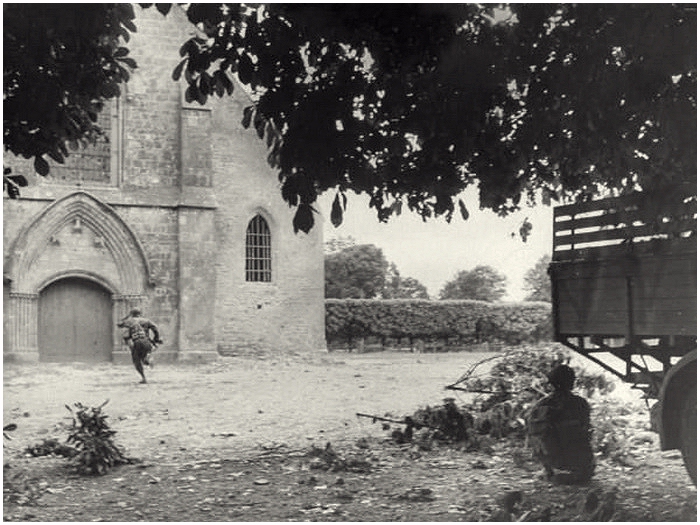 The church at Ste-Mère-Église under attack, Then and Now 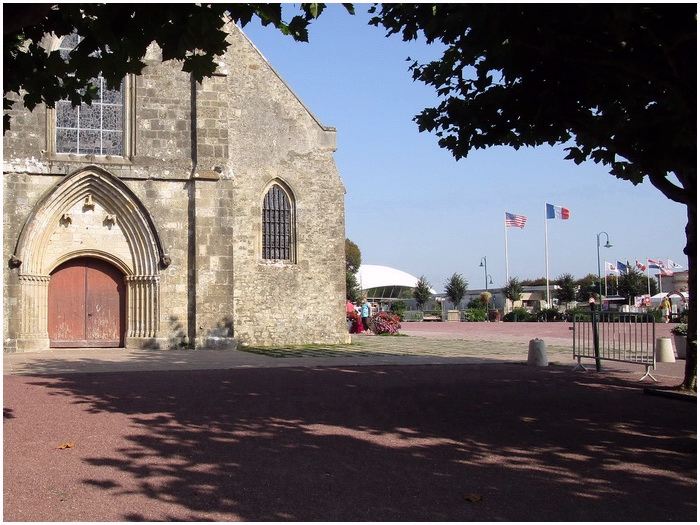
THE AIRBORNE MUSEUM IN STE-MÈRE-ÉGLISE: The museum, with roofs like parachutes, across the church is well worth a visit, reserve at least 2 hours. Under one roof an original Waco CG-4 can be found. In cabinets a lot of items donated by veterans are on display. Under another roof is an authentic C-47 transporter on display. (C-47 page is under translation). The hardware outside are an M4 Sherman tank and a GMC truck.
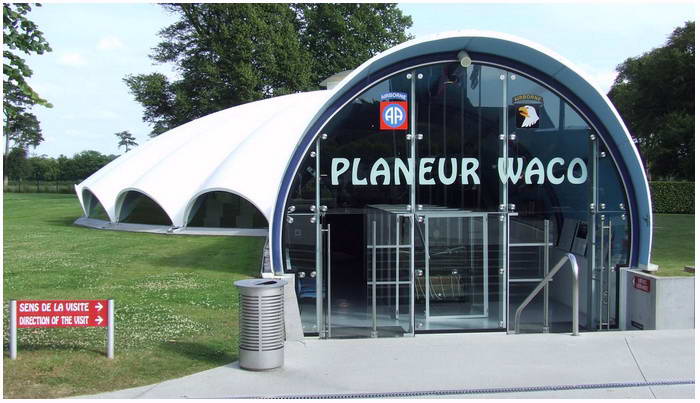
In 2014 a new wing was opened for the public at the Airborne Museum. This is a state of the art exhibition hall. Once inside you move through the cabin of C-47 loaded with paratroopers. With a feeling of being airborne, you ‘step’ out into the dark, surrounded by anti-aircraft fire. Instead of falling to earth, you walk across a large glass plate to the next exhibition. 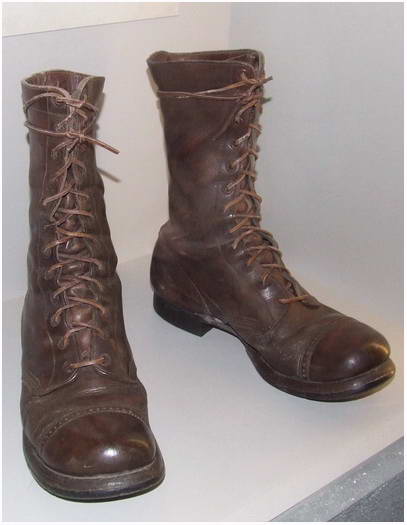 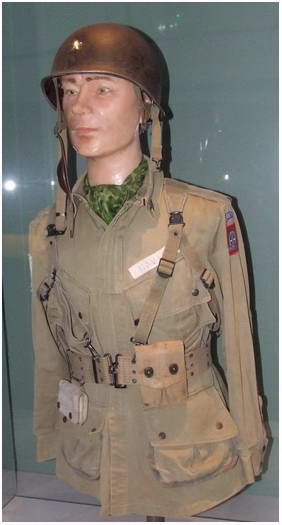 The 'jumpboots' from Ken Russell and the uniform from General GavinThere are very nice mannequins with good looking facial expressions who represent the real men they portray. They are dressed in the real uniforms donated by the high officers, such as General Gavin, Lt.Col. Vandervoort, General Ridgeway, but also from DeGlopper, the Medal of Honor bearer. In a cabinet the medals from John Steel are on display, beside the ‘jumpboots’ from Ken Russell (both men were hanging from the church during the night jump over Ste-Mère-Église). This new wing is a must see when visiting the museum. 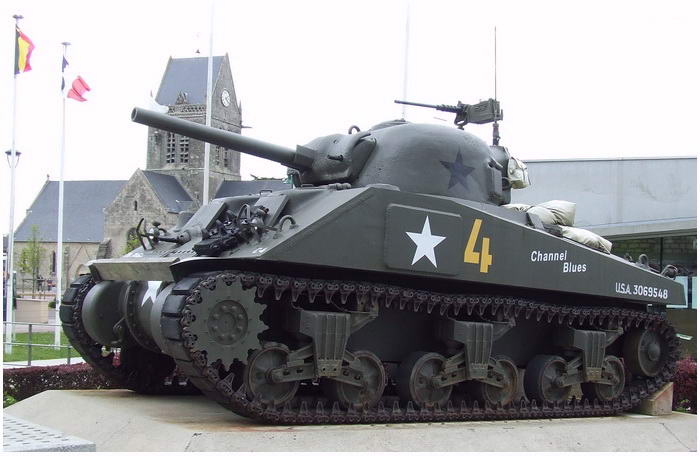 In 2017 a ‘new’ Sherman tank was placed in the museumIn 2016 another pavilion was opened on the museum grounds. It does not looks large, but that is because a cinema is built into it in the rear. In the first room are cabinets full of artifacts that remind us to the ‘Battle of the Bulge’, fought in the Belgium Ardennes during December 1944. This exhibition is in cooperation with the museum in Bastogne, in Belgium. For years an M4A1(76)W Sherman tank of a later version that saw no action during the Battle for Normandy. In February 2017 another Sherman tank replaced the former. This, an M4A4, looks the real deal, with the standard 75mm gun. But this is also a type that is not quite what it seems. It was rebuilt after the war by the French to house a Contineltal engine (a so called M4A4(T)).
On the next page the tour continous
to the hard fought bridges across the river Merderet.
Click on 'Iron Mike' below
|